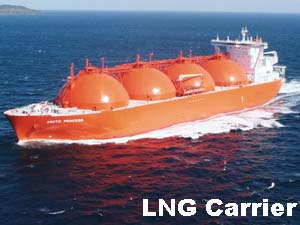
The LNG carrier (Liquified Natural Gas) and it's cousin the LPG carrier (Liquified Petroleum Gas) are products of the late twentieth century. LNG and LPG are the preferred fuel types of certain countries for their industrial power needs. Japan is one such country, and so LNG needs to be transported to Japan, but is not the easiest of cargoes to be transported. In its natural state, LNG is a gas, so to transport it, it needs to be either pressurised into a liquified form, or kept as a liquid by reducing the temperature.
The shape of the LNG Carrier is quite unmistakable, with the shape of the Moss tanks (which are like enormous spherical thermos flasks !) visible along the deck, which has led to the nickname of "Dinosaur Eggs Carriers". An alternative design is known as the "membrane" type, which allows for a more standard shape of vessel without the "eggs".
Obviously, the carriage of an explosive gas - kept at below freezing temperatures as an unstable liquid presents a very dangerous cargo, yet it is for this very fact, that LNG Carriers have about the best safety record of all maritime vessels. Only the best officers and crews are employed on these vessels, and the vessels themselves are maintained meticulously, and renewed frequently. There have been accidents involving LNG / LPG carriers, but where such events have occurred, the crews or salvors have so far, successfully managed to vent off the cargo into the atmosphere, thus rendering the lethal cargo harmless.


|